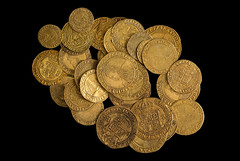
PREV ARTICLE
NEXT ARTICLE
FULL ISSUE
PREV FULL ISSUE
SHAKESPEAREAN NUMISMATICS AT THE BRITISH MUSEUM
The British Museum is mounting an exhibit of its own on the money and medals of Shakespeare and
his era.
-Editor
Shakespeare's plays are full of coins, from the English crowns to the Venetian ducat, and references and metaphors were constantly related to money and coins as a way of indicating identity, legitimacy and reputation. More specifically they were used as a means of plot development, as audiences were expected to recognise the coins that were featured and pick up on messages about value, wealth and character. In The Merchant of Venice for example, which begins with the fateful loan of three thousand ducats made by Shylock to Antonio, the audience is assumed to know what a ducat is worth (about £100 today) and what the stakes are. In almost every scene that features Falstaff in Henry IV, there contains a monetary reference or joke that reflects on his character and role; from tipping with a notoriously bad coin, 'Hold, there's a tester for thee', to defending himself through a money metaphor, 'Dost thou hear, Hal? Never call a true piece of gold a counterfeit. Thou are essentially mad, without seeming so.' The role of money in the Elizabethan and Jacobean theatre will also be explored in this display. In many respects Shakespeare and his generation invented commercial theatre as part of a new world of public entertainment that was dependent on popular appeal whilst also firmly linked to the royal court. Medals, for example, were quite new in England and were given out and worn as signs of allegiance and fidelity, a fact that adds further bitterness to the reference Shakespeare uses in The Winters Tale when King Leontes's jealously describes his wife as hanging round the neck of the visiting King of Bohemia, 'Why, he that wears her like a medal hanging / About his neck, Bohemia'. Objects on display include Nicholas Hilliard's 'Dangers Averted' medal of Elizabeth I and William Roper's print of Elizabeth, which was the first print to be dated and signed by an English artist. There is an example of the sort of money box that would have been used at the Globe Theatre; as well as a hoard of gold coins that was deposited in Essex around the time of Shakespeare's birth which includes a Venetian ducat. Nearly every type of coin mentioned in Shakespeare's plays, from 'crack'd drachmas' to 'gilt twopences' will also be on display. Curator Barrie Cook said, 'This exhibition began as an attempt to investigate what Shakespeare tells us about the coins of his time. What I hadn't realised was, and what is so wonderful, is that when he talks about coins, he is as likely to be commenting on the people around him as about money."
To read the complete article, see:
Crowns and ducats: Shakespeare's money and medals at the British Museum
(www.artdaily.org/index.asp?int_sec=2&int_new=54834)
The Numismatic Bibliomania Society is a non-profit organization promoting numismatic literature. See our web site at coinbooks.org. To submit items for publication in The E-Sylum, write to the Editor at this address: whomren@gmail.com To subscribe go to: https://my.binhost.com/lists/listinfo/esylum All Rights Reserved. NBS Home Page Contact the NBS webmaster 
|
